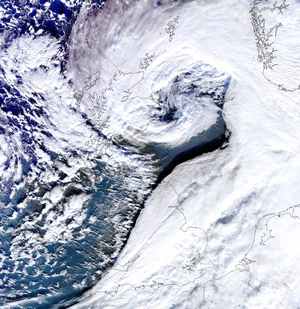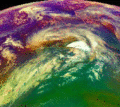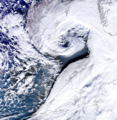European windstorm facts for kids

A European windstorm is an extratropical cyclone that affects Europe. They are normally caused by areas of low atmospheric pressure that move across the North Atlantic towards northwestern Europe. They are most common in the winter months. Low pressure areas are common over the North Atlantic. They sometimes start as nor'easters off the New England coast. They usually move past the north coasts of the British Isles to the Norwegian Sea. When they move south, they can affect almost any country in Europe. These most often affect Britain, Ireland, Norway, the Faroe Islands and Iceland. They can affect any country in central, northern and western Europe.
These storms cause economic damage of €1.9 billion each year. They cause insurance costs of €1.4 billion yearly (1990–1998). Only US hurricanes cause more insurance costs of all natural disasters.
Images for kids
-
2015 list of storm names from UK Met Office and Met Éireann
-
A fictitious synoptic chart of an extratropical cyclone affecting Great Britain & Ireland. The blue and red arrows between isobars indicate the direction of the wind and its relative temperature, while the "L" symbol denotes the center of the "low". Note the occluded cold and warm frontal boundaries.
-
Contemporary picture of the flood that struck the North Sea coast of Germany and Denmark in October 1634.
See also
 In Spanish: Borrasca profunda europea para niños
In Spanish: Borrasca profunda europea para niños







